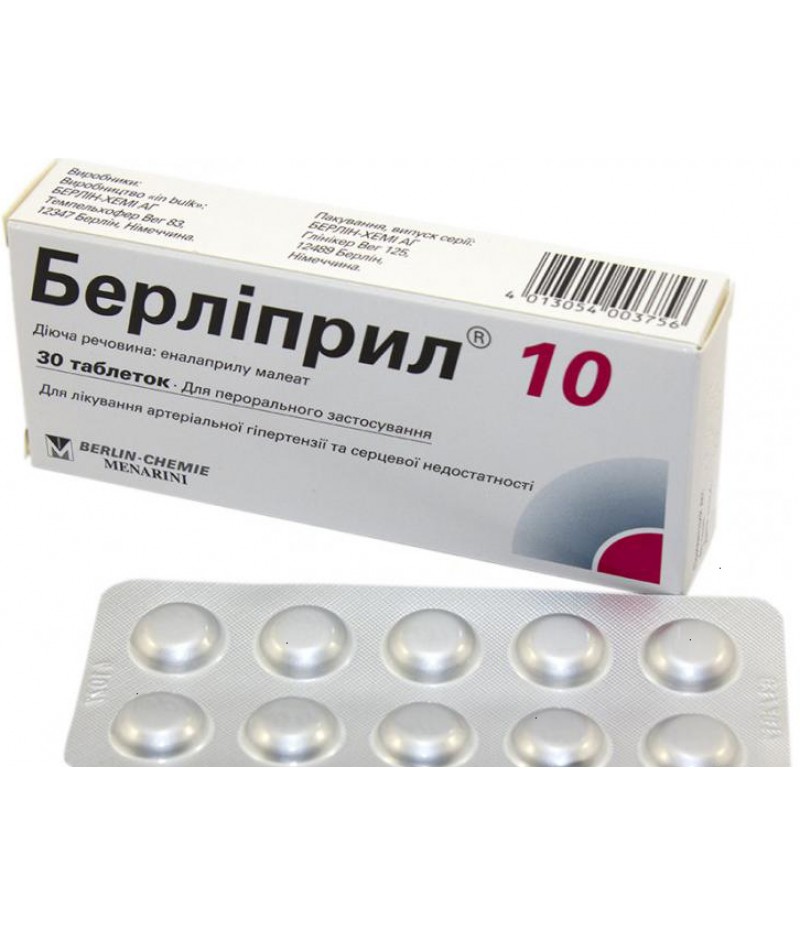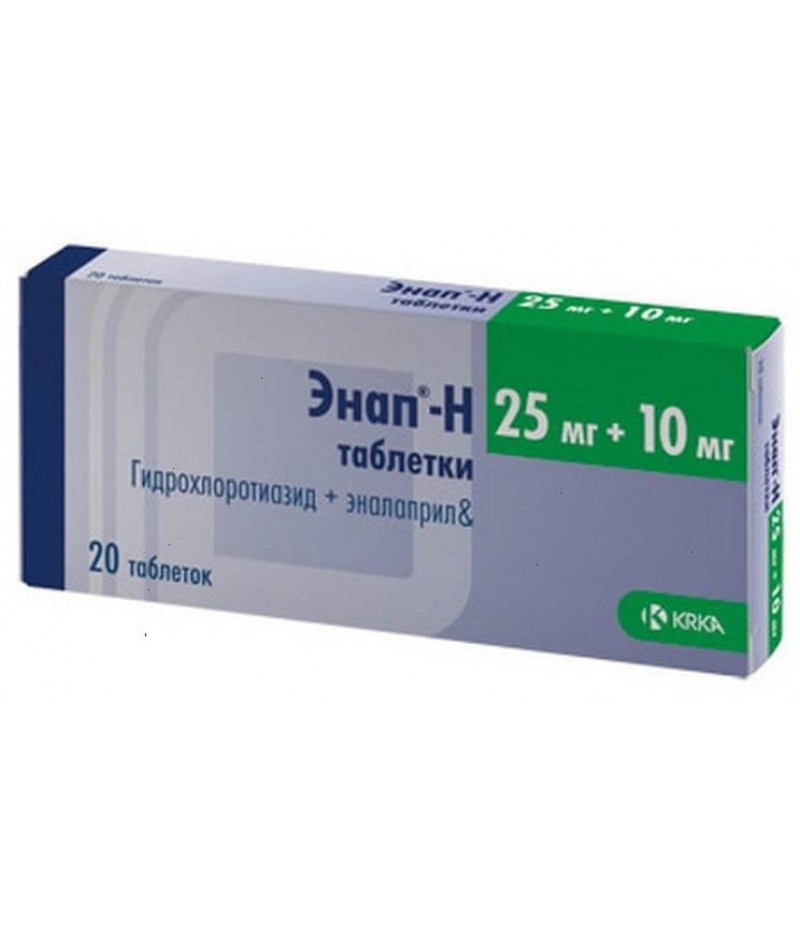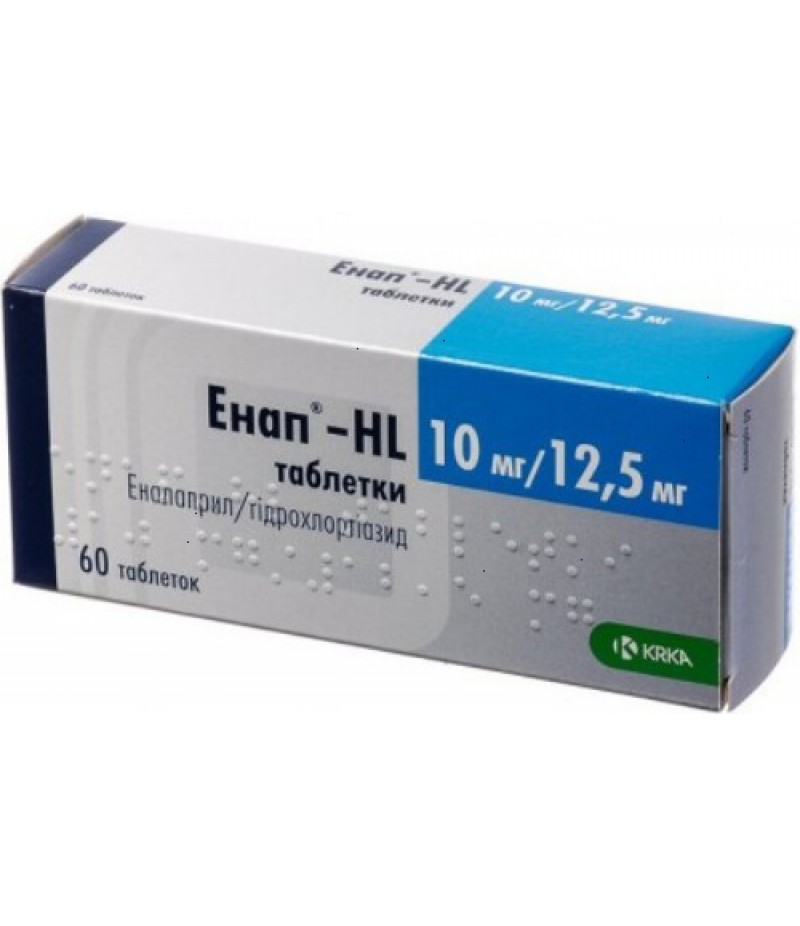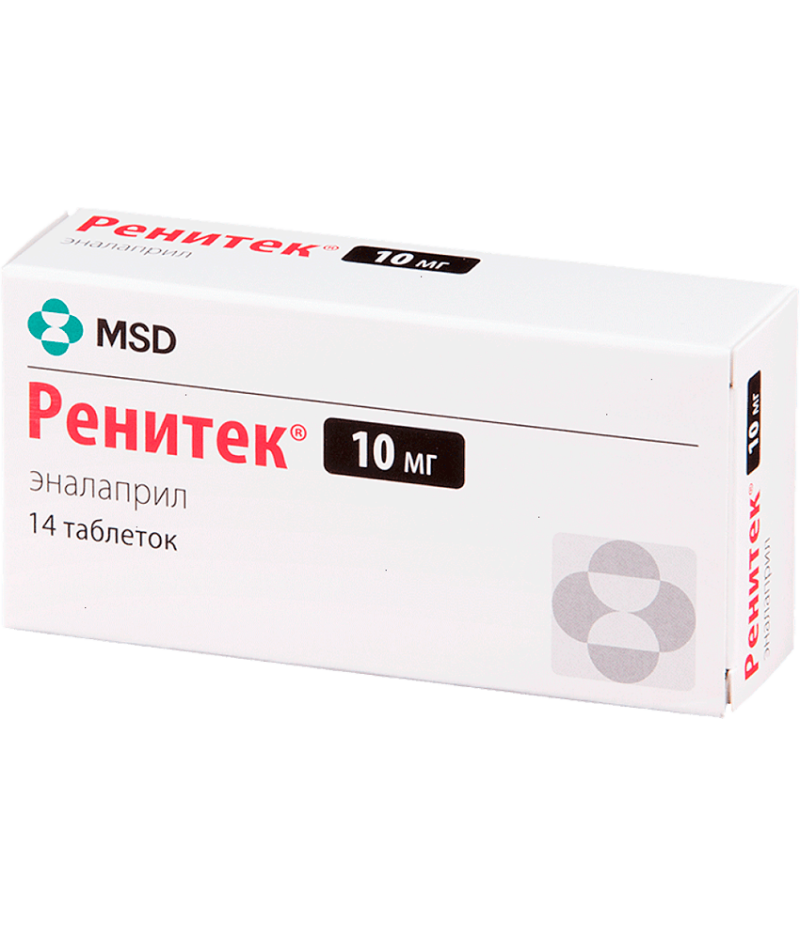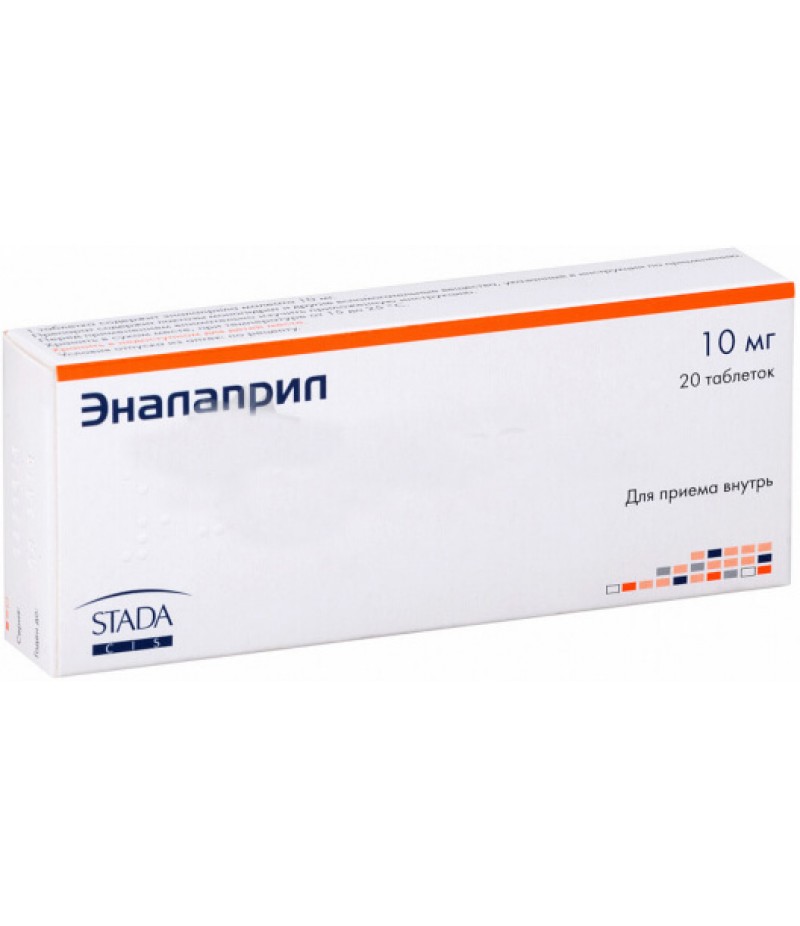Enap tabs 10mg #60
- $14.35
- 3 or more $14.18
- Availability:In Stock
Enap user manualReed more and buy Enap on this pageSee also - Enap-HTo buy Enap at other dosage just contact usCompositionThe composition of the Enap medicinal product includes the active ingredient enalapril maleate (may contain ..
Tags: tabs
Enap user manual
Reed more and buy Enap on this page
See also - Enap-H
To buy Enap at other dosage just contact us
Composition
The composition of the Enap medicinal product includes the active ingredient enalapril maleate (may contain 2.5 mg / 5 mg / 10 mg / 20 mg).
Also in the preparation contains additional components: sodium bicarbonate, corn starch, magnesium stearate, lactose monohydrate, giprolose, dye, talc.
Form of issue
Enap tablets are produced containing different amounts of the active ingredient.
Means Enap 2.5 mg - is white or almost white tablets, biconvex, round, with a bevel. Packed in blisters of 10 pcs.
Means Enap 5 mg - a white or almost white tablets, flat-cylindrical, with a facet and a risk. Packed in blisters of 10 pcs.
Means Enap 10 mg - a red-brown tablets, flat-cylindrical, with a facet and a risk. There may be white and burgundy impregnations inside and on the surface of the tablet. Packed in blisters of 10 pcs.
Means Enap 20 mg - is light orange tablets, flat-cylindrical, with a facet and a risk. There may be impregnations of white and brown-burgundy color inside and on the surface of the tablet. Packed in blisters of 10 pcs.
In packs of cardboard - 2, 3, 6 blisters.
pharmachologic effect
The drug Enap - hypotensive drug. The mechanism of action of enalapril is based on the inhibition of ACE activity, resulting in a decrease in angiotensin II production.
The substance Enalapril is a derivative of amino acids: L-alanine and L-proline. After the substance has been taken orally, it is hydrolyzed to enalaprilat, which inhibits ACE. Under his influence, the production of angiotensin I angiotensin II decreases, in view of the decrease in its level in plasma, an increase in plasma renin activity and a decrease in the secretion of aldosterone are noted. Since the ACE is identical to kininase II, there is the ability of enalapril to block the destruction of bradykinin (a peptide that produces a vasopressor effect). At the moment, it is not completely known what the significance of this effect is in the mechanism of action of enalapril.
The antihypertensive effect of the active substance is primarily related to the inhibition of RAAS activity, playing an important role in the process of regulation of blood pressure. But even in people with elevated blood pressure and low renin concentration, anti-hypertensive effects of enalapril are noted.
After applying this drug, BP is lowered regardless of the position of the human body, but the heart rate does not increase significantly.
The development of symptomatic orthostatic hypotension occurs only in rare cases. Sometimes, in order to achieve a marked reduction in pressure, it takes several weeks for the medication to be taken. With a sharp withdrawal of the drug, there was no increase in blood pressure.
The pronounced inhibition of ACE activity is usually noted 2-4 hours after ingestion of the tablet. The antihypertensive effect is usually felt 1 hour after taking drugs, the maximum effect occurs after 4-6 hours. The duration of action depends on the dose of the drug. If the patient takes those doses Enap, which he recommended a doctor, then the hemodynamic and antihypertensive effect is maintained for at least 24 hours.
In people who suffer from essential hypertension, a decrease in peripheral vascular resistance and an increase in cardiac output are noted with a decrease in blood pressure. However, there is no significant change in heart rate. Renal blood flow increases, changes in glomerular filtration rate are not observed. But there is an increase in this indicator in people with a low glomerular filtration rate.
In people with diabetic and non-diabetic nephropathy, albuminuria / proteinuria and IgG excretion by the kidneys decreased with enalapril.
In patients suffering from CHF in the treatment of diuretics and cardiac glycosides and the use of enalapril, there is a decrease in blood pressure, OPSS, cardiac output growth, a decrease in heart rate (as a rule, in people with chronic heart failure, this parameter is increased).
There is a decrease in wedging of pulmonary capillaries. With prolonged intake of tablets enalapril increases tolerance to physical loads, reduces the severity of manifestations of heart failure. In people with CHF in mild and moderate form, the drug slows the progression of the disease, also reduces the rate of dilatation of the left ventricle.
In people suffering from left ventricular dysfunction, Enap reduces the likelihood of manifestation of major ischemic outcomes (the incidence of myocardial infarction decreases, and the number of hospitalizations due to angina decreases).
Pharmacokinetics and pharmacodynamics
After reception enalaprila marked rapid absorption - the degree of absorption is about 60%. The greatest concentration of enalapril in the blood is observed 1 hour after application, while intake of food for absorption is not affected. The substance is actively hydrolyzed, during which enalaprilate, an ACE inhibitor is formed. The greatest concentration of enalaprilat is fixed 3-4 hours after oral administration. With repeated use of enalapril, the elimination half-life is 11 hours.
Significant biotransformation of enalapril in the body is not exposed, except for the conversion of the substance into enalaprilat.
Basically, the body is excreted by the kidneys. In urine, enalaprilat is determined in a dose of 40% and unaltered enalapril in a dose of 20%.
Indications for use Enap
The following indications for Enap's application are determined:
essential hypertension;
CHF (in combined treatment);
with the aim of preventing the manifestation of severe heart failure in those patients diagnosed with asymptomatic left ventricular dysfunction (in combination therapy);
to reduce the incidence of myocardial infarction;
with the aim of reducing the frequency of hospitalization of people with unstable angina.
From what tablets Enap, and whether it is necessary to apply them in each concrete case, the patient should consult the doctor.
Contraindications
There are such contraindications to the use of Enap:
increased sensitivity to the enalapril substance, as well as to other components of the drug;
angioedema in history, which developed during the treatment with ACE inhibitors;
idiopathic angioedema, and Quincke's edema of hereditary type;
porphyria;
application simultaneously with aliskiren in patients with kidney disease or with diabetes mellitus;
syndrome of glucose-galactose malabsorption, lactose intolerance, lack of lactase (in the composition of LS Enap is lactose);
pregnancy and the period of natural feeding;
age of the patient is under 18 years.
Tablets from the pressure Enap carefully designate:
people with stenosis of the renal arteries;
patients with hyperkalemia;
people after kidney transplantation;
with primary hyperaldosteronism;
with a reduced BCC;
hypertrophic obstructive cardiomyopathy;
stenosis of the mitral, aortic;
IHD;
systemic ailments of connective tissue;
diabetes mellitus;
oppression of hematopoiesis;
cerebrovascular diseases;
renal failure.
Careful medicine for pressure needs to be taken to people who follow a diet with reduced content of table salt, to those who are on hemodialysis and to those who take diuretics and immunosuppressants.
Before taking Enap, people who are already 65 years old must consult a doctor.
Side effects
In the treatment, such side effects can be noted (negative effects in each group are given in order from more frequent to more rare):
hematopoiesis: anemia, neutropenia, a decrease in the concentration of hematocrit and hemoglobin, agranulocytosis, thrombocytopenia, oppression of hematopoiesis, pancytopenia, autoimmune diseases, lymphadenopathy;
metabolism: hypoglycemia;
nervous system: depression, headache, impaired consciousness, drowsiness, insomnia, paresthesia, high excitability, vertigo, sleep disturbances;
heart and blood vessels: dizziness, marked decrease in blood pressure, chest pain, angina pectoris, heart rhythm disturbance, heart palpitations, stroke or myocardial infarction, Raynaud's syndrome;
sensory organs: changes in taste, a sense of noise in the ears, blurred vision;
digestion: diarrhea, nausea, flatulence, abdominal pain, intestinal obstruction, constipation, vomiting, pancreatitis, dyspepsia, anorexia, dry mouth mucosa, peptic ulcer, biliary dysfunction and liver function, hepatitis, hepatic necrosis, glossitis, cholestasis, stomatitis, aphthous ulcers;
respiratory system: cough, sore throat, rhinorrhea, hoarseness, bronchospasm, dyspnea, allergic alveolitis, eosinophilic pneumonia, rhinitis;
skin: rash, manifestations of hypersensitivity, angioedema, sweating, itching, alopecia, urticaria, erythema multiforme, erythroderma, exfoliative dermatitis, epidermal toxic necrolysis, pemphigus;
genitourinary system: disruption of kidney function, proteinuria, renal failure, impotence, gynecomastia, oliguria;
musculoskeletal system: muscle cramps;
indicators of laboratory studies: hyperkalemia, increased serum creatinine level; hyponatremia; an increase in the concentration of urea in the blood of hepatic enzyme activity, the level of bilirubin in the blood;
other manifestations: the syndrome of inadequate secretion of ADH, fever, myalgia, myositis, arthritis, vasculitis, serositis, leukocytosis, increased ESR, photosensitivity reactions.
Enap tablets, instructions for use (Method and dosage)
The official instruction on the use of Enap provides that the drug is taken orally by patients, regardless of food intake. It is recommended to drink the medicine at the same time of the day, washing down with a small amount of liquid.
When hypertension is initially prescribed in a dose of 5 to 20 mg once a day, the dosage depends on the severity of hypertension. In the case of hypertension, an intake of 5 mg or 10 mg per day is recommended in a mild degree.
In people with severe activation of RAAS, blood pressure can go down too much. In this case, it is recommended to use low doses of the drug - 5 mg per day, under the supervision of a specialist.
Before taking the medicine, you need to take into account that the previous treatment with large doses of diuretics can lead to dehydration and increase the risk of arterial hypotension at the very beginning of treatment. In this case, it is recommended to apply a dose of not more than 5 mg per day. It is necessary to stop taking diuretics 2-34 days before the start of enap. In the process of treatment it is important to monitor the condition of the kidneys, to determine the content of potassium in the blood.
The maintenance dose is 20 mg once a day. If there is such a need, then the daily dose is increased to 40 mg, the dosage is determined individually.
With CHF, as well as with left ventricular dysfunction, the initial dose is 2.5 mg per day. Sometimes diuretics, beta-adrenoblockers, cardiac glycosides are prescribed for the treatment of heart failure.
After correction of arterial hypertension, the dose can be gradually increased - by 2.5-5 mg every 3-4 days, bringing it up to a supporting dose of 20 mg per day. The maximum allowable dose is 40 mg per day.
Since in the process of treatment there is a chance of developing renal insufficiency and arterial hypotension, you need to carefully monitor the pressure and kidney function in the treatment process. There is no need to cancel the drug if hypotension developed after the first dose.
People with kidney diseases need to increase the intervals between tablets or lower the dose of the drug.
Elderly people are recommended to use the initial dose of 1.25 mg Enap, because the rate of excretion of enalapril in them is slowed down.
Overdose
If an overdose occurs, after about 6 hours, there is a marked decrease in blood pressure. Collapse may occur, the water-electrolyte balance may be disturbed, hyperventilation, renal failure, bradycardia, dizziness, tachycardia, convulsions, and palpitations may also occur due to an overdose.
In case of an overdose, the person should be transferred to a horizontal position, while the head should be at the level of the body. If the overdose is mild, you need to rinse the stomach, give activated charcoal. Practiced in severe cases of an overdose of Enap in / in the introduction of 0.9% solution of sodium chloride, can also practice the intake of intravenous plasma substitutes, catecholamines.
Enalaprilat can be removed from the body by hemodialysis, the rate of excretion is 62 ml per minute.
People with bradycardia are staged by the pacemaker. In case of overdose, careful monitoring of serum electrolyte content and creatinine concentration should be performed.
Interaction
With a double blockade of RAAS, that is, in the case of simultaneous administration of ACE inhibitors, angiotensin II receptor antagonists, or aliskiren, the risk of arterial hypotension increases. If this combination is necessary, carefully monitor the kidneys, water-electrolyte balance, blood pressure.
Contraindicated to combine enalapril and aliskiren to people with diabetes and kidney disease.
ACE inhibitors reduce potassium loss under the influence of diuretics. When using enalapril and potassium-sparing diuretics, potassium-containing products, and potassium-containing substitutes, hyperkalemia may develop. With this combination, it is important to monitor the serum potassium content
With prior therapy with diuretics, BCC can decrease and the likelihood of developing arterial hypotension in the enalapril administration increases. This effect can be reduced by eliminating diuretics, increasing the daily intake of water and salt, lowering the dosage of enalapril.
With the simultaneous use of alpha-adrenoblockers, beta-blockers, methyldopa, BCC, ganglion blocking agents, nitroglycerin or other nitrates with enalapril, an additional reduction in blood pressure is likely.
When taken in parallel with lithium preparations, there is a transient increase in the concentration of lithium, as well as intoxication with lithium. When taking thiazide diuretics, an increase in serum lithium concentration is possible. Such combinations are not recommended, if necessary, careful monitoring of serum lithium concentrations is important.
When you take concomitantly with enalapril a number of anesthetics, antipsychotics, tricyclic antidepressants, BP may decrease further.
When taking concomitantly with Enap, NSAIDs may reduce the antihypertensive effect. There may also be a worsening of kidney function, especially in those patients who suffer from kidney disease. The effect is reversible.
When taking hypoglycemic drugs and insulin simultaneously with Enap, hypoglycemic action may become more active and the risk of hypoglycemia increases.
The antihypertensive effect of the drug is enhanced by ethanol.
Sympathomimetics reduce the antihypertensive effect of ACE inhibitors.
Enalapril reduces the effect of drugs, in which there is theophylline.
With the simultaneous administration of Enap immunosuppressants, cytostatics, and allopurinol, the likelihood of leukopenia increases. In people with impaired renal function, taking allopurinol and ACE inhibitors increases the risk of allergies.
The use of enalapril and cyclosporine simultaneously leads to an increase in the likelihood of hyperkalemia.
When taking antacids, the bioavailability of ACE inhibitors decreases.
Terms of sale
To buy Enap you don't need a prescription from the doctor.
Storage conditions
Enap should be protected from children, stored at a temperature of up to 25 ° C.
Shelf life - 3 years.
special instructions
After the first dose of Enap can develop arterial hypotension. With severe hypotension, the patient should be placed horizontally, if necessary, to administer 0.9% sodium chloride solution.
After the patient's condition is stabilized, treatment can be continued.
It is not recommended to take Enap to people who had a kidney transplanted.
Very rarely in the process of treatment, a syndrome originating with cholestatic jaundice and hepatitis can develop, later it develops into liver necrosis. If the patient has jaundice, stop the treatment immediately and consult a specialist.
There are descriptions of cases of neutropenia or agranulocytosis in people using ACE inhibitors.
It is very cautious to use this medicine for people with connective tissue diseases, provided that they undergo immunosuppressive treatment, take procainamide, allopurinol. In this case, it is possible to develop severe infections that are not treated with antibiotics. When receiving Enap such patients need periodic monitoring of the level of leukocytes in the blood.
There is a possibility of angioedema in people receiving Enap. At the first signs of this condition, an immediate withdrawal of the drug and an appeal to a doctor are needed. An increased risk of developing this condition was noted in patients with angioedema in the anamnesis.
In the process of taking the drug in rare cases, the development of anaphylactoid reactions in people who have been desensitized by the venom of Hymenoptera has been noted.
In the process of taking medication, patients may develop an unproductive dry cough that disappears after the enalapril cancellation.
It is necessary to warn specialists that the patient is taking Enap, before performing surgical operations with general anesthesia.
It is important to carefully drive transport and practice other activities that require concentration of attention when treating Enap.
Enap and Enap H - differences
Enap H contains hydrochlorothiazide and enalapril, that is, in addition to the hypotensive, this agent also produces a diuretic effect.
Children
It is not prescribed for children under 18 years of age.
With alcohol
Alcohol and ingestion of Enap should not be combined, since alcohol activates the hypotensive effect of tablets.
In pregnancy and lactation
It is impossible to drink Enap to pregnant women in the first trimester, and in the subsequent months of pregnancy. To date, the risk of developing teratogenic effects is not excluded. If pregnancy was confirmed, then the remedy should be canceled immediately.
If a woman took ACE inhibitors during pregnancy, you should periodically perform ultrasound to assess the level of the amniotic fluid, carry out ultrasound of the bones of the skull and kidneys of the fetus. The active substance is determined in breast milk, therefore, lactation at the time of treatment should be discontinued.
Reviews about Enap
Estimates of the Enap means, the doctors' reviews of its effectiveness are mostly positive. Experts agree that if the drug is properly administered, the patient can significantly improve the quality of life. In this process, various side effects often occur during treatment. Users often mention that they are concerned about dry cough, etc. It is important to remember that when the condition worsens, you should immediately consult a doctor who will adjust the dosage or prescribe another drug.


